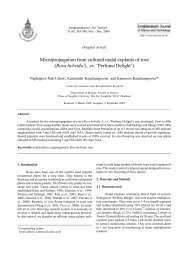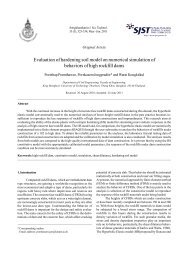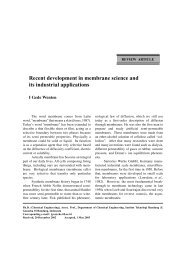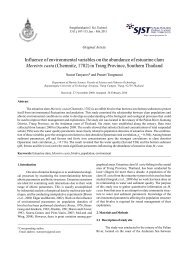lyase (PAL) activity in mangosteen
lyase (PAL) activity in mangosteen
lyase (PAL) activity in mangosteen
You also want an ePaper? Increase the reach of your titles
YUMPU automatically turns print PDFs into web optimized ePapers that Google loves.
Effects of bagg<strong>in</strong>g and storage temperature on<br />
anthocyan<strong>in</strong> content and phenylalan<strong>in</strong>e ammonia<strong>lyase</strong><br />
(<strong>PAL</strong>) <strong>activity</strong> <strong>in</strong> <strong>mangosteen</strong> (Garc<strong>in</strong>ia<br />
mangostana L.) fruit pericarp dur<strong>in</strong>g maturation<br />
Sujitra Ratanamarno 1 , Jamnong Uthaibutra 2<br />
and Kobkiat Saengnil 3<br />
ORIGINAL ARTICLE<br />
Abstract<br />
Ratanamarno, S. 1 , Uthaibutra, J. 2 and Saengnil, K. 3<br />
Effects of bagg<strong>in</strong>g and storage temperature on anthocyan<strong>in</strong> content and<br />
phenylalan<strong>in</strong>e ammonia-<strong>lyase</strong> (<strong>PAL</strong>) <strong>activity</strong> <strong>in</strong> <strong>mangosteen</strong> (Garc<strong>in</strong>ia<br />
mangostana L.) fruit pericarp dur<strong>in</strong>g maturation<br />
Songklanakar<strong>in</strong> J. Sci. Technol., 2005, 27(4) : 711-717<br />
The purpose of this research is to <strong>in</strong>vestigate the effect of bagg<strong>in</strong>g and storage temperature on<br />
anthocyan<strong>in</strong> content and phenylalan<strong>in</strong>e ammonia-<strong>lyase</strong> (<strong>PAL</strong>) <strong>activity</strong> of <strong>mangosteen</strong> fruit pericarp. Six<br />
maturity stages (stage 1 to stage 6, def<strong>in</strong>ed by the extension of red or purple colouration on the pericarp) of<br />
attached <strong>mangosteen</strong> fruits with bagged and unbagg<strong>in</strong>g were compared. It was found that sunlight had no<br />
significant effect on both anthocyan<strong>in</strong> content and <strong>PAL</strong> <strong>activity</strong>. The effect of storage temperature on<br />
anthocyan<strong>in</strong> content and <strong>PAL</strong> <strong>activity</strong> were also studied. Fruits at stage 1 (<strong>in</strong>dicated by scattered of p<strong>in</strong>k spot<br />
on pericarp) were harvested and allowed to develop red colour to stage 6 at different storage temperatures:<br />
1 Ph.D.(Biology), Asst. Prof., Department of Postharvest Technology, Faculty of Eng<strong>in</strong>eer<strong>in</strong>g and Agro-Industry,<br />
Maejo University, Chiang Mai, 50290 Thailand. 2 Ph.D.(Postharvest Physiology), Asst. Prof., 3 Ph.D.(Applied<br />
Biochemistry), Asst. Prof., Department of Biology, Faculty of Science, Chiang Mai University, Chiang Mai,<br />
50200 Thailand.<br />
Correspond<strong>in</strong>g e-mail: sujitra@mju.ac.th<br />
Received, 5 July 2004 Accepted, 15 October 2004
Songklanakar<strong>in</strong> J. Sci. Technol.<br />
Vol.27 No.4 Jul. - Aug. 2005 712<br />
Bagg<strong>in</strong>g and storage temperature on anthocyan<strong>in</strong> content and <strong>PAL</strong><br />
Ratanamarno, S., et al.<br />
15º, 25º, 30º (room temperature) and 35ºC. It was found that temperature had no effect on anthocyan<strong>in</strong><br />
content <strong>in</strong> any stage of fruit development. At all temperature levels, the anthocyan<strong>in</strong> content was <strong>in</strong>creased<br />
accord<strong>in</strong>gly and had the highest level at stage 6. Temperature affected on <strong>PAL</strong> <strong>activity</strong> at different stages.<br />
Levels of <strong>PAL</strong> <strong>activity</strong> decreased at the early stages and <strong>in</strong>creased at the f<strong>in</strong>al stage of maturity except for<br />
fruits held at 25ºC, <strong>PAL</strong> <strong>activity</strong> rema<strong>in</strong>ed at a low level through stage 6, while fruit at 35ºC had the highest<br />
level of <strong>PAL</strong> at stage 5.<br />
Key words : <strong>mangosteen</strong>, anthocyan<strong>in</strong>, phenylalan<strong>in</strong>e ammonia-<strong>lyase</strong> (<strong>PAL</strong>)<br />
∫∑§—¥¬àÕ<br />
ÿ®‘µ√“ √µπ–¡‚π 1 ®”πߧå Õÿ∑—¬∫ÿµ√ 2 ·≈–°Õ∫‡°’¬√µ‘ · ßπ‘≈ 2<br />
º≈¢Õß°“√ÀàÕº≈·≈–Õÿ≥À¿Ÿ¡‘„π°“√‡°Á∫√—°…“µàÕª√‘¡“≥√ߧ«—µ∂ÿ·≈–°‘®°√√¡¢Õ߇Õπ‰´¡å<br />
øïπ‘≈Õ≈“π’π·Õ¡‚¡‡π’¬‰≈‡Õ „π‡ª≈◊Õ°º≈¡—ߧÿ¥√–À«à“ß°“√ ÿ°·°à<br />
«. ߢ≈“π§√‘π∑√å «∑∑. 2548 27(4) : 711-717<br />
°“√∑¥≈Õßπ’ È¡’«—µ∂ÿª√– ߧå‡æ◊ËÕ»÷°…“º≈¢Õß°“√ÀàÕº≈¡—ߧÿ¥·≈–Õÿ≥À¿Ÿ¡‘„π°“√‡°Á∫√—°…“∑’<br />
Ë¡’µàÕ°“√‡ª≈’ ˬπ<br />
·ª≈ߪ√‘¡“≥¢Õß·Õπ‚∑‰´¬“π‘π·≈–°‘®°√√¡¢Õ߇Õπ‰´¡åøïπ‘≈Õ≈“π’π ·Õ¡‚¡‡π’¬‰≈‡Õ (<strong>PAL</strong>) ¢Õ߇ª≈◊Õ°º≈<br />
¡—ߧÿ¥„π√–À«à“ß°“√æ—≤π“ ’¢≥–∑’ ˺≈¡’°“√ ÿ°·°à (√–¬–∑’ Ë 1 ∂÷ß√–¬–∑’ Ë 6 ¥Ÿ®“°°“√°√–®“¬¢Õß ’¡à«ß·¥ß∫π‡ª≈◊Õ°<br />
º≈) ‚¥¬∑”°“√ÀàÕº≈·≈–‰¡àÀàÕº≈∫πµâπ¥â«¬∂ÿß°√–¥“… æ∫«à“· ߉¡à¡’º≈µàÕ°“√‡ª≈’ ˬπ·ª≈ß°‘®°√√¡¢Õ߇Õπ‰´¡å<br />
<strong>PAL</strong> ·≈–ª√‘¡“≥·Õπ‚∑‰´¬“π‘π ‚¥¬°‘®°√√¡¢Õ߇Õπ‰´¡å·≈–ª√‘¡“≥·Õπ‚∑‰´¬“π‘π„πº≈∑’ËÀàÕ·≈–‰¡àÀàÕ‡¡◊ËÕ<br />
‡ª√’¬∫‡∑’¬∫°—π„π∑ÿ°√–¬–¡’§à“‰¡à·µ°µà“ß°—π∑“ß ∂‘µ‘ à«π°“√»÷°…“º≈¢ÕßÕÿ≥À¿Ÿ¡‘¢≥–‡°Á∫√—°…“π—Èπ∑”‚¥¬°“√<br />
‡°Á∫º≈¡—ߧÿ¥®“°µâπ„π√–¬–∑’ Ë 1 π”¡“‡°Á∫√—°…“‰«â∑’ ËÕÿ≥À¿Ÿ¡‘·µ°µà“ß°—π 4 √–¥—∫ §◊Õ 15, 25, 30 (Õÿ≥À¿Ÿ¡‘ÀâÕß)<br />
·≈– 35appleC ‡¡◊ËÕº≈¡—ߧÿ¥¡’°“√æ—≤π“¢Õß ’·¥ß‡æ‘Ë¡¢÷Èπ„π√–À«à“ß°“√ ÿ°·°à√–¬–µà“ßÊ ‰ª®π∂÷ß√–¬–∑’Ë 6 æ∫«à“<br />
Õÿ≥À¿Ÿ¡‘„π°“√‡°Á∫√—°…“‰¡à¡’º≈µàÕª√‘¡“≥·Õπ‚∑‰´¬“π‘π„π∑ÿ°√–¬– ∑— Èßπ’ È„π∑ÿ°√–¥—∫Õÿ≥À¿Ÿ¡‘ ª√‘¡“≥·Õπ‚∑-<br />
‰´¬“π‘π¡’·π«‚π⡇æ‘Ë¡¢÷Èπ„π∑‘»∑“߇¥’¬«°—π·≈–¡’ª√‘¡“≥ Ÿß ÿ¥„π√–¬–∑’Ë 6 ·µàÕÿ≥À¿Ÿ¡‘¡’º≈µàÕ°“√‡ª≈’ˬπ·ª≈ß<br />
°‘®°√√¡¢Õ߇Õπ‰´¡å <strong>PAL</strong> „π·µà≈–√–¬–¢Õß·µà≈–Õÿ≥À¿Ÿ¡‘∑’ˇ°Á∫√—°…“ ‚¥¬°‘®°√√¡¢Õ߇Õπ‰´¡å¡’·π«‚πâ¡≈¥≈ß<br />
„π√–¬–·√°Ê ·≈–‡æ‘Ë¡ Ÿß¢÷Èπ„π√–¬–À≈—ß ¬°‡«âπº≈∑’ˇ°Á∫∑’ËÕÿ≥À¿Ÿ¡‘ 25appleC °‘®°√√¡¢Õ߇Õπ‰´¡å¬—ß§ß¡’§à“µË”„π<br />
√–¬–∑’ Ë 6 ¢Õß°“√ ÿ°·°à¢Õߺ≈·≈–º≈∑’ ˇ°Á∫√—°…“∑’ ËÕÿ≥À¿Ÿ¡‘ 35appleC ¡’°‘®°√√¡¢Õ߇Õπ‰´¡å Ÿß ÿ¥∑’ Ë√–¬–∑’ Ë 5<br />
1 ¿“§«‘“‡∑§‚π‚≈¬’À≈—ß°“√‡°Á∫‡°’ ˬ« §≥–«‘»«°√√¡·≈–Õÿµ “À°√√¡‡°…µ√ ¡À“«‘∑¬“≈—¬·¡à‚®â Õ”‡¿Õ —π∑√“¬ ®—ßÀ«—¥‡’¬ß„À¡à<br />
50290 2 ¿“§«‘“’««‘∑¬“ §≥–«‘∑¬“»“ µ√å ¡À“«‘∑¬“≈—¬‡’¬ß„À¡à Õ”‡¿Õ‡¡◊Õß ®—ßÀ«—¥‡’¬ß„À¡à 50200<br />
Fruit colour, an important market<strong>in</strong>g<br />
attribute of <strong>mangosteen</strong> (Garc<strong>in</strong>ia mangostana L.),<br />
<strong>in</strong>fluences both consumer acceptance and sales.<br />
The attractive purplish-red of <strong>mangosteen</strong> is<br />
ma<strong>in</strong>ly anthocyan<strong>in</strong>. The major pigment is<br />
cyanid<strong>in</strong>-3-sophoroside, and the m<strong>in</strong>or pigment is<br />
cyanid<strong>in</strong>-3-glucoside (Du and Francis, 1977).<br />
Mangosteen is ready to harvest when pericarp is<br />
light greenish yellow scatter<strong>in</strong>g with p<strong>in</strong>kish spots,<br />
m<strong>in</strong>imum stage for harvest<strong>in</strong>g (Tongdee and<br />
Suwanagul, 1989). Total anthocyan<strong>in</strong> content<br />
<strong>in</strong>creased cont<strong>in</strong>uously dur<strong>in</strong>g maturation and<br />
reach<strong>in</strong>g a maximum value at fully ripe stage<br />
(Ratanamarno et al., 1999).<br />
Environmental and cultural factors <strong>in</strong>fluence<br />
fruit colour development. Temperature and light<br />
are two environmental factors that are important<br />
for red pigment development <strong>in</strong> fruit (Saure,<br />
1990). Anthocyan<strong>in</strong> synthesis <strong>in</strong> the apple fruit cv.<br />
Jonathan is light-dependent and may be further<br />
stimulated by several treatments <strong>in</strong>clud<strong>in</strong>g UV light<br />
(Chalmers and Faragher, 1977). Kliewer (1970)
Songklanakar<strong>in</strong> J. Sci. Technol.<br />
Vol.27 No.4 Jul. - Aug. 2005<br />
found that the level of anthocyan<strong>in</strong> <strong>in</strong> P<strong>in</strong>ot noir<br />
berries was considerably less under low light than<br />
under high light. Further evidence <strong>in</strong>dicat<strong>in</strong>g that<br />
light is important <strong>in</strong> the colouration of grapes is<br />
found by visually compar<strong>in</strong>g berries from different<br />
positions on a cluster. The berries that are best<br />
exposed to solar radiation usually have darker<br />
colour than berries least exposed to light, especially<br />
<strong>in</strong> the low-pigmented table grape varieties. Bagg<strong>in</strong>g<br />
of mango cv. Keitt, the percentage of the sk<strong>in</strong><br />
with red colour, and its <strong>in</strong>tensity decreased with<br />
<strong>in</strong>creas<strong>in</strong>g duration of bagg<strong>in</strong>g (Hofman et al.,<br />
1977). In the sk<strong>in</strong> of mango fruit cv. Kent, the<br />
<strong>in</strong>crease <strong>in</strong> red peel colour did not occur <strong>in</strong> the<br />
bagged group (Saengnil et al., 1997).<br />
Anthocyan<strong>in</strong> synthesis <strong>in</strong> several plant tissue<br />
is associated with <strong>in</strong>creased L-phenylalan<strong>in</strong>e<br />
ammonia-<strong>lyase</strong> (<strong>PAL</strong>) <strong>activity</strong>. Aoki et al. (1970)<br />
observed <strong>PAL</strong> <strong>activity</strong> only <strong>in</strong> the red parts of the<br />
apple sk<strong>in</strong> and concluded that <strong>PAL</strong> <strong>activity</strong> was<br />
closely related to the formation of anthocyan<strong>in</strong>.<br />
In apple sk<strong>in</strong>, Faragher and Chalmers (1977)<br />
studied the effect of UV light and wound<strong>in</strong>g on<br />
anthocyan<strong>in</strong> synthesis and <strong>PAL</strong> <strong>activity</strong>, and<br />
suggested that <strong>PAL</strong> controlled the rate of anthocyan<strong>in</strong><br />
synthesis <strong>in</strong> whole fruit sk<strong>in</strong>.<br />
Although anthocyan<strong>in</strong> production is often<br />
associated with an <strong>in</strong>crease <strong>in</strong> <strong>PAL</strong> <strong>activity</strong>, there<br />
are many examples of <strong>PAL</strong> <strong>activity</strong> without<br />
anthocyan<strong>in</strong> production. This is because <strong>PAL</strong> is<br />
active <strong>in</strong> the biosynthesis of a wide range of<br />
phenylpropanoid compounds, such as substituted<br />
c<strong>in</strong>namic acids and their CoA-ester and conjugates<br />
of these such as chlorogenic acid, coumar<strong>in</strong> and<br />
lign<strong>in</strong> (Lister et al., 1996).<br />
In this study, it was aimed to <strong>in</strong>vestigate<br />
anthocyan<strong>in</strong> synthesis and <strong>PAL</strong> <strong>activity</strong> <strong>in</strong><br />
<strong>mangosteen</strong> fruit pericarp dur<strong>in</strong>g maturation <strong>in</strong><br />
response to light and storage temperature.<br />
Materials and Methods<br />
Fruit: Experimental fruits were harvested<br />
at random from the trees of 35 years old from<br />
the commercial orchard, "Wang Nam Kang" <strong>in</strong><br />
Amphoe Maewang, Chiang Mai prov<strong>in</strong>ce, Thai-<br />
Bagg<strong>in</strong>g and storage temperature on anthocyan<strong>in</strong> content and <strong>PAL</strong><br />
713<br />
Ratanamarno, S., et al.<br />
land.<br />
Experiment 1: To <strong>in</strong>vestigate the effect of<br />
light on anthocyan<strong>in</strong> content and <strong>PAL</strong> <strong>activity</strong>,<br />
fruits at the age of 14 days after full bloom were<br />
bagged us<strong>in</strong>g two layer paper bag. The fruit<br />
maturity stage was determ<strong>in</strong>ed by visual exam<strong>in</strong>ation<br />
accord<strong>in</strong>g to Tongdee and Suwanagul<br />
(1989). Six different stages of fruits were def<strong>in</strong>ed<br />
by the extent of red or purple colouration on the<br />
pericarp: Stage 1 (pericarp light greenish yellow<br />
with scattered p<strong>in</strong>kish spots, m<strong>in</strong>imum stage for<br />
harvest<strong>in</strong>g), Stage 2 (pericarp light greenish yellow<br />
or yellowish p<strong>in</strong>k with dist<strong>in</strong>ct irregular p<strong>in</strong>k spots<br />
cover<strong>in</strong>g the entire fruit), Stage 3 (pericarp background<br />
p<strong>in</strong>kish, spots not as dist<strong>in</strong>ct as <strong>in</strong> stage 2,<br />
a stage commonly harvested commercially), Stage<br />
4 (pericarp red to reddish brown, some with purple<br />
t<strong>in</strong>ge), Stage 5 (pericarp darkened to reddish purple,<br />
best eat<strong>in</strong>g stage), Stage 6 (pericarp purple, dark<br />
purple to black with slight or no red colouration<br />
rema<strong>in</strong><strong>in</strong>g). Each stage of fruits was taken for<br />
anthocyan<strong>in</strong> and <strong>PAL</strong> determ<strong>in</strong>ation.<br />
Experiment 2: The effect of storage temperature<br />
on anthocyan<strong>in</strong> content and <strong>PAL</strong> <strong>activity</strong><br />
was exam<strong>in</strong>ed. Fruit were harvested at stage 1<br />
(pericarp light greenish yellow with scattered<br />
p<strong>in</strong>kish spots) and place <strong>in</strong> corrugated box of 30x<br />
40x10 cm. Each side of the box has two holes of<br />
2.3 cm <strong>in</strong> diameter. Fruits were stored at 15ºC (85<br />
%RH), 25ºC (85 %RH), 30ºC (70-80 %RH) (room<br />
temperature) and 35ºC (65 %RH). When the<br />
colours of the fruits were developed to stage 2, 3,<br />
4, 5 and 6 (<strong>in</strong>dicated by colour as above), fruits<br />
from each stage were taken for anthocyan<strong>in</strong> and<br />
<strong>PAL</strong> determ<strong>in</strong>ation.<br />
Anthocyan<strong>in</strong> extraction and determ<strong>in</strong>ation:<br />
Two grams of fruit pericarp was extracted <strong>in</strong> 100<br />
ml of ethanol conta<strong>in</strong><strong>in</strong>g 1%HCL, us<strong>in</strong>g estimation<br />
of total anthocyan<strong>in</strong> method (Ranganna, 1977).<br />
Absorbance was measured at 535 nm us<strong>in</strong>g a<br />
Spectrophotometer 20 D+. Results were expressed<br />
as mg of total anthocyan<strong>in</strong> content per 100 g fresh<br />
weight.<br />
Phenylalan<strong>in</strong>e ammonia-<strong>lyase</strong> (<strong>PAL</strong>) extraction<br />
and assay: Two-hundred milligrams of<br />
acetone powder of fruit pericarp was extracted
Songklanakar<strong>in</strong> J. Sci. Technol.<br />
Vol.27 No.4 Jul. - Aug. 2005 714<br />
with 20 ml of 0.1 M borate buffer (pH 8.8) at 4ºC<br />
for 15 m<strong>in</strong>utes and then was centrifuged at13,500<br />
rpm for 30 m<strong>in</strong>utes at 4ºC. The supernatant which<br />
was crude enzyme was used for enzyme assay.<br />
The <strong>activity</strong> of <strong>PAL</strong> was determ<strong>in</strong>ed by<br />
spectrophotometry by measur<strong>in</strong>g the rate of transc<strong>in</strong>namic<br />
acid formation as <strong>in</strong>creased absorbance<br />
at 280 nm. The mixtures conta<strong>in</strong>ed 2 ml of 0.1 M<br />
borate buffer (pH 8.8), 1 ml of 60 mM phenylalan<strong>in</strong>e<br />
and 1 ml of the crude enzyme was<br />
<strong>in</strong>cubated at 30ºC for 1 hour, then the reaction<br />
stopped by add<strong>in</strong>g 1 ml of 2 N perchloric acid. The<br />
reaction rate was measured by us<strong>in</strong>g a record<strong>in</strong>g<br />
spectrophotometer. Results were expressed as<br />
nmole/mg prote<strong>in</strong> ●hr. (or unit/mg prote<strong>in</strong>). Prote<strong>in</strong><br />
measurement was determ<strong>in</strong>ed accord<strong>in</strong>g to the<br />
modified procedure of Lowry et al. (1951).<br />
Results and Discussion<br />
Anthocyan<strong>in</strong> content <strong>in</strong>creased cont<strong>in</strong>uously<br />
dur<strong>in</strong>g maturation <strong>in</strong> both bagged and unbagged<br />
fruits (Figure 1). At stage 6 bagged fruits had<br />
higher anthocyan<strong>in</strong> content than those non-bagged<br />
with non-statistically significant difference. It was<br />
Figure 1. Changes <strong>in</strong> anthocyan<strong>in</strong> contents <strong>in</strong><br />
<strong>mangosteen</strong> fruits pericarp dur<strong>in</strong>g<br />
maturation bagged (o) and unbagg<strong>in</strong>g<br />
( ●) (Vertical bars <strong>in</strong>dicate standard<br />
deviations of n<strong>in</strong>e replicates).<br />
Bagg<strong>in</strong>g and storage temperature on anthocyan<strong>in</strong> content and <strong>PAL</strong><br />
Ratanamarno, S., et al.<br />
found that bagg<strong>in</strong>g <strong>mangosteen</strong> fruits had no effect<br />
on anthocyan<strong>in</strong> synthesis. It was contrary to many<br />
fruits which light had an effect on anthocyan<strong>in</strong><br />
synthesis such as litchi cv. Ohea (Y<strong>in</strong>dee, 1996),<br />
litchi cv. Tai So (Tyas et al., 1998), mango cv.<br />
Kent (Saengnil et al., 1997 and Rimpranam, 1998),<br />
grape cv. Emperor (Kliewer, 1977), apple cv.<br />
Stark<strong>in</strong>g Delicious and cv. Fuji (Arakawa et al.,<br />
1986) and apple cv. Jonathan (Faragher and<br />
Brohier, 1984).<br />
<strong>PAL</strong> <strong>activity</strong> <strong>in</strong> <strong>mangosteen</strong> fruit pericarp<br />
of both fruit with and without bagg<strong>in</strong>g was not<br />
significantly difference (Figure 2). <strong>PAL</strong> <strong>activity</strong><br />
was decreased cont<strong>in</strong>uously from stage 1 to stage<br />
6 <strong>in</strong> unbagged fruit, while <strong>in</strong> bagged fruit it was<br />
<strong>in</strong>creased from stage 1 to stage 2, then decreased<br />
and rema<strong>in</strong>ed relatively constant until stage 5 and<br />
<strong>in</strong>creased aga<strong>in</strong> <strong>in</strong> stage 6.<br />
Accord<strong>in</strong>g to Ju et al. (1995) who <strong>in</strong>vestigated<br />
the relationship between anthocyan<strong>in</strong><br />
accumulation and <strong>PAL</strong> <strong>activity</strong> us<strong>in</strong>g apple fruits<br />
on the tree, the changes <strong>in</strong> anthocyan<strong>in</strong> accumulation<br />
can occur <strong>in</strong>dependently of changes <strong>in</strong> <strong>PAL</strong><br />
<strong>activity</strong>; the <strong>in</strong>crease of anthocyan<strong>in</strong> dur<strong>in</strong>g<br />
maturation <strong>in</strong>volved additional enzymes between<br />
Figure 2. <strong>PAL</strong> <strong>activity</strong> <strong>in</strong> <strong>mangosteen</strong> fruits<br />
pericarp dur<strong>in</strong>g maturation bagged (o)<br />
and unbagg<strong>in</strong>g ( ●) (Vertical bars <strong>in</strong>dicate<br />
standard deviations of n<strong>in</strong>e<br />
replicates).
Songklanakar<strong>in</strong> J. Sci. Technol.<br />
Vol.27 No.4 Jul. - Aug. 2005<br />
Figure 3. Changes <strong>in</strong> anthocyan<strong>in</strong> contents <strong>in</strong><br />
<strong>mangosteen</strong> fruits pericarp dur<strong>in</strong>g<br />
maturation at different storage temperatures<br />
15ºC ( ●), 25ºC (o), 30ºC (RT)<br />
( ) and 35ºC (×) (Vertical bars <strong>in</strong>dicate<br />
standard deviations of n<strong>in</strong>e<br />
replicates).<br />
leucocyanid<strong>in</strong> and cyanid<strong>in</strong> glycocides. They also<br />
suggested that when the precursors of anthocyan<strong>in</strong><br />
synthesis <strong>in</strong> bagged apples were deficient, <strong>PAL</strong><br />
was critical for pigment formation. However, when<br />
such precursors were sufficient, as <strong>in</strong> the case of<br />
mature fruit, changes of <strong>PAL</strong> <strong>activity</strong> did not<br />
regulate anthocyan<strong>in</strong> accumulation.<br />
<strong>PAL</strong> <strong>in</strong>duction and anthocyan<strong>in</strong> formation<br />
responsed to different endogenous controls <strong>in</strong><br />
previous studies. In apple, <strong>PAL</strong> can be <strong>in</strong>duced by<br />
a wide range of factors <strong>in</strong>clud<strong>in</strong>g wound<strong>in</strong>g,<br />
temperature, lights and chemicals and can be<br />
<strong>in</strong>duced at any fruit developmental stages (Saure,<br />
1990). Wang et al. (2000) reported that <strong>PAL</strong> is<br />
not the only regulat<strong>in</strong>g factor for anthocyan<strong>in</strong><br />
accumulation <strong>in</strong> bagged mature and ripe Jonathan<br />
apples.<br />
Anthocyan<strong>in</strong> contents <strong>in</strong> <strong>mangosteen</strong> fruit<br />
pericarp stored at different temperatures 15º, 25º,<br />
30º (RT) and 35ºC were <strong>in</strong>creased accord<strong>in</strong>gly<br />
from stage 1 to stage 6 and had the highest level<br />
of anthocyan<strong>in</strong> at stage 6 (Figure 3). The fruits<br />
stored at 35ºC had the highest anthocyan<strong>in</strong> content<br />
Bagg<strong>in</strong>g and storage temperature on anthocyan<strong>in</strong> content and <strong>PAL</strong><br />
715<br />
Ratanamarno, S., et al.<br />
Figure 4. <strong>PAL</strong> <strong>activity</strong> <strong>in</strong> <strong>mangosteen</strong> fruits<br />
pericarp dur<strong>in</strong>g maturation at different<br />
storage temperatures 15ºC ( ●), 25ºC (o),<br />
30ºC (RT) ( ) and 35ºC (×) (Vertical<br />
bars <strong>in</strong>dicate standard deviations of<br />
n<strong>in</strong>e replicates).<br />
followed by at 30º, 15º and 25ºC, respectively, with<br />
non-statistically difference. Temperature had an<br />
effect on <strong>PAL</strong> <strong>activity</strong> at different stages of fruit<br />
development. Levels of <strong>PAL</strong> <strong>activity</strong> decreased at<br />
the early stage and <strong>in</strong>creased at the f<strong>in</strong>al stage of<br />
fruit maturity except fruits held at 25ºC, <strong>PAL</strong><br />
<strong>activity</strong> rema<strong>in</strong>ed at low level through stage 6,<br />
while fruits at 35ºC had the highest level of <strong>PAL</strong><br />
at stage 5 (Figure 4).<br />
Faragher (1983) reported that a shift of<br />
temperature affects the course of fruit development:<br />
<strong>in</strong> detached 'Jonagold' apples, the optimum<br />
for anthocyan<strong>in</strong> accumulation was 12ºC <strong>in</strong> unripe<br />
and 16-24ºC <strong>in</strong> ripe fruit at constant illum<strong>in</strong>ation.<br />
Besides, anthocyan<strong>in</strong> accumulation <strong>in</strong> ripe apples<br />
at 23ºC exceeded that at 17ºC.<br />
The role of temperature seems to be<br />
ambivalent for anthocyan<strong>in</strong> formation: low<br />
temperature may contribute to colour formation by<br />
directly reduc<strong>in</strong>g GA <strong>activity</strong>, but high temperatures<br />
are also required for proper fruit development<br />
and timely maturation, be<strong>in</strong>g the prerequisite for<br />
<strong>in</strong>creased ethylene and ABA <strong>activity</strong>. Obviously,
Songklanakar<strong>in</strong> J. Sci. Technol.<br />
Vol.27 No.4 Jul. - Aug. 2005 716<br />
proper temperature management with alternat<strong>in</strong>g<br />
temperatures could be helpful <strong>in</strong> anthocyan<strong>in</strong><br />
formation, but is rarely feasible for economic<br />
reasons (Saure,1990).<br />
Faragher (1983) also reported that levels of<br />
<strong>PAL</strong> <strong>activity</strong> were higher at low temperature than<br />
that of high temperatures, and <strong>in</strong>creased <strong>in</strong>activation<br />
of <strong>PAL</strong> by high temperature, <strong>in</strong> conjunction<br />
with ripen<strong>in</strong>g and light, was more likely than direct<br />
stimulation of <strong>PAL</strong> by low temperature.<br />
This experiment was found that detached<br />
<strong>mangosteen</strong> fruits at early maturity stage (pericarp<br />
light greenish yellow with scattered p<strong>in</strong>kish spots)<br />
with bagg<strong>in</strong>g and unbagg<strong>in</strong>g were capable of<br />
accumulated anthocyan<strong>in</strong> dur<strong>in</strong>g fruit colour<br />
development to fully ripe stage <strong>in</strong>dependently of<br />
changes <strong>in</strong> <strong>PAL</strong> <strong>activity</strong>. This research also showed<br />
that bagg<strong>in</strong>g of <strong>mangosteen</strong> fruits has potential to<br />
improve fruit quality and added benefits on visual<br />
appearance. Moreover, fruit bagg<strong>in</strong>g prevents<br />
fruits from <strong>in</strong>sect <strong>in</strong>festation especially the fruit<br />
fly. This practice will enhance export<strong>in</strong>g quality of<br />
<strong>mangosteen</strong> fruit; however, further economic<br />
assessments are needed.<br />
References<br />
Aoki, S., Araki, C., Kaneo, K. and Katayama, O. 1970.<br />
L-phenylalan<strong>in</strong>e ammonia <strong>lyase</strong> activities <strong>in</strong><br />
Japanese chestnut, strawberry, apple fruit and<br />
bracken. J. Food Sci. Technol. 17: 507-511.<br />
Arakawa, O., Hori, Y. and Ogata, R. 1986. Characteristics<br />
of colour development and relationship between<br />
anthocyan<strong>in</strong> synthesis and phenylalan<strong>in</strong>e<br />
ammonia-<strong>lyase</strong> <strong>activity</strong> <strong>in</strong> 'Stark<strong>in</strong>g Deliciousí',<br />
'Fuji' and 'Mutsu' apple fruits. J. Japan. Soc.<br />
Hort. Sci. 54: 424-430.<br />
Du, C.T. and Francis, F.J. 1977. Anthocyan<strong>in</strong>s of<br />
<strong>mangosteen</strong>, Garc<strong>in</strong>ia mangostana L., J. Food<br />
Sci. 42: 1667.<br />
Faragher, J.D. 1983. Temperature regulation of anthocyan<strong>in</strong><br />
accumulation <strong>in</strong> apple sk<strong>in</strong>. J. Exp. Bot.<br />
34: 1291-1298.<br />
Faragher, J.D. and Broheir, R.L. 1984. Anthocyan<strong>in</strong><br />
accumulation <strong>in</strong> apple sk<strong>in</strong> dur<strong>in</strong>g ripen<strong>in</strong>g:<br />
regulation by ethylene and phenylalan<strong>in</strong>e<br />
ammonia-<strong>lyase</strong>. Sci. Hortic. 22: 89-96.<br />
Bagg<strong>in</strong>g and storage temperature on anthocyan<strong>in</strong> content and <strong>PAL</strong><br />
Ratanamarno, S., et al.<br />
Faragher, J.D. and Chalmers, D.J. 1977. Regulation of<br />
anthocyan<strong>in</strong> synthesis <strong>in</strong> apple sk<strong>in</strong>. III. Involvement<br />
of phenylalan<strong>in</strong>e ammonia-<strong>lyase</strong>. Aust.<br />
J. Plant Physiol. 4: 133-141.<br />
Hofman, P.J., Smith, L.G., Joyce, D.C., Johnson, G.I.<br />
And Meiburg, G. F. 1997. Bagg<strong>in</strong>g of mango<br />
(Mangifera <strong>in</strong>dica cv. 'Kiett') fruit <strong>in</strong>fluences<br />
fruit quality and m<strong>in</strong>eral composition. Postharvest<br />
Biol. Technol. 12: 83-91.<br />
Ju, Z.G., Yuan, Y.B., Liou, C.L. and X<strong>in</strong>, S.H. 1995.<br />
Relationships among phenylalan<strong>in</strong>e ammonia<strong>lyase</strong><br />
<strong>activity</strong>, simple phenol concentrations and<br />
anthocyan<strong>in</strong> accumulation <strong>in</strong> apple. Sci. Hortic.<br />
61: 215-226.<br />
Kliewer, W.M. 1970. Effect of day temperature and<br />
light <strong>in</strong>tensity on coloration of Vitis v<strong>in</strong>ifera L.<br />
grapes. J. Amer. Soc. Hort. Sci. 95: 693-697.<br />
Kliewer, W.M. 1977. Influence of temperature, solar<br />
radiation and nitrogen on coloration and composition<br />
of Emperor grapes. Am. J. Enol. Vitic.<br />
28: 96-103.<br />
Lister , C.E., Lancaster, J.E. and Walker, J.R.L. 1996.<br />
Phenylalan<strong>in</strong>e ammonia-<strong>lyase</strong> (<strong>PAL</strong>) <strong>activity</strong><br />
and its relationship to anthocyan<strong>in</strong> and flavonoid<br />
levels <strong>in</strong> New Zealand-grown apple cultivars.<br />
J. Amer. Soc. Hort. Sci. 121: 281-285.<br />
Lowry, O.H., Rosebrough, N.J., Far, A.L. and Randall,<br />
R.J. 1951. Prote<strong>in</strong> measurement with the Fol<strong>in</strong><br />
phenol reagent. J. Biol. Chem. 193: 265-275.<br />
Ranganna, S. 1977. Plant pigments. In S. Ranganna<br />
(ed.): Manual of Analysis of Fruit and Vegetable<br />
Products. Tata McGraw-Hill Publish<strong>in</strong>g Co., Ltd.<br />
New Delhi. pp. 72-93.<br />
Ratanamarno, S., Uthaibutra, J. and Saengnil, K. 1999.<br />
Towards some quality attributes of <strong>mangosteen</strong><br />
(Garc<strong>in</strong>ia mangostana L.) fruit dur<strong>in</strong>g maturation.<br />
Songklanakar<strong>in</strong> J. Sci. Technol. 21: 9-15.<br />
Rimpranam, D. 1998. Effect of fruit bagg<strong>in</strong>g and some<br />
plant growth regulators on pigment changes of<br />
ëKentí mango peel dur<strong>in</strong>g fruit development.<br />
Master thesis, Department of Biology, Faculty<br />
of Science, Chiang Mai University, Chiang Mai.<br />
(In Thai with English abstract) 122 p.<br />
Saengnil, K., Kaewlublae, M. and Uthaibutra, J. 1997.<br />
Changes <strong>in</strong> red colour and pigment content of<br />
attached mango fruit sk<strong>in</strong> with and without
Songklanakar<strong>in</strong> J. Sci. Technol.<br />
Vol.27 No.4 Jul. - Aug. 2005<br />
bagg<strong>in</strong>g. Songklanakar<strong>in</strong> J. Sci. Technol. 19(2):<br />
173-180.<br />
Saure, M.C. 1990. External control of anthocyan<strong>in</strong><br />
formation <strong>in</strong> apple. Sci Hortic. 42: 181-218.<br />
Tongdee, S.C. and Suwanagul, A. 1989. Postharvest<br />
mechanical damage <strong>in</strong> <strong>mangosteen</strong>s. ASEAN<br />
Food J., 4: 151-155.<br />
Tyas, J.A., Hofman, P.J., Underhill, S.J.R. and Bell, K.<br />
L. 1998. Fruit canopy position and panicle<br />
bagg<strong>in</strong>g affects yield and quality of 'Tai So'<br />
lychee. Scientia Hortic. 72: 203-213.<br />
Bagg<strong>in</strong>g and storage temperature on anthocyan<strong>in</strong> content and <strong>PAL</strong><br />
717<br />
Ratanamarno, S., et al.<br />
Wang, H., Arakawa, O. and Motomura, Y. 2000.<br />
Influence of maturity and bagg<strong>in</strong>g on the<br />
relationship between anthocyan<strong>in</strong> accumulation<br />
and phenylalan<strong>in</strong>e ammonia-<strong>lyase</strong> (<strong>PAL</strong>) <strong>activity</strong><br />
<strong>in</strong> 'Jonathan' apples. Postharvest Biol. Technol.<br />
19: 123-128.<br />
Y<strong>in</strong>dee A. 1996. Pigment changes <strong>in</strong> mango and lychee<br />
fruits dur<strong>in</strong>g pre- and post-harvest periods.<br />
Master thesis, Department of Biology, Faculty<br />
of Science, Chiang Mai University, Chiang Mai.<br />
(In Thai with English abstract) 157 p.


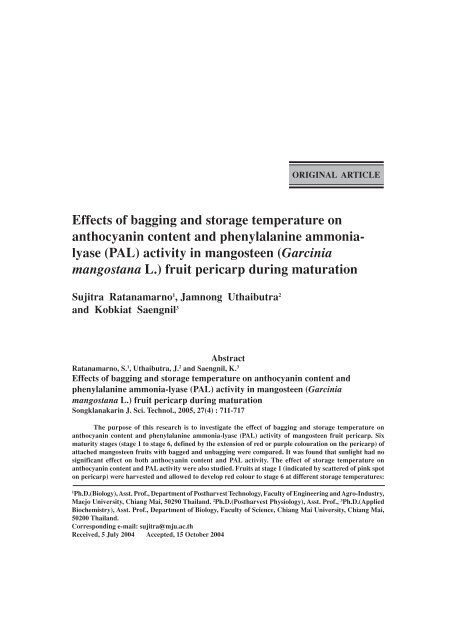
![PDF [578 K]](https://img.yumpu.com/19892772/1/184x260/pdf-578-k.jpg?quality=85)
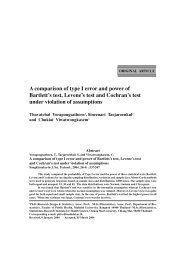
![PDF [835 K]](https://img.yumpu.com/16670486/1/184x260/pdf-835-k.jpg?quality=85)

![PDF [334 K]](https://img.yumpu.com/15675288/1/184x260/pdf-334-k.jpg?quality=85)
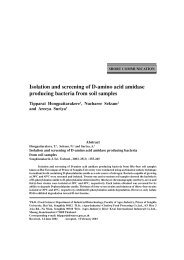
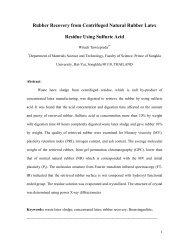
![PDF [925 K]](https://img.yumpu.com/13132196/1/184x260/pdf-925-k.jpg?quality=85)
